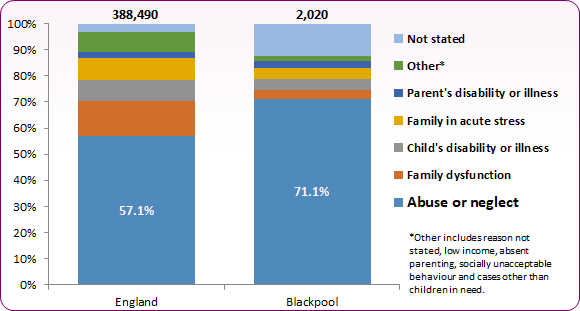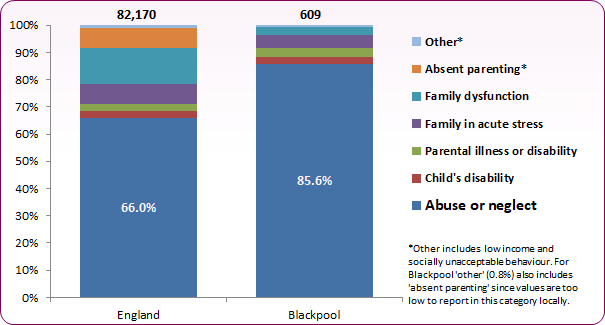Child neglect
Last Modified 28/03/2023 14:24:33
Share this page
Introduction
Neglect is the most common form of child abuse, with up to one in 10 children across the UK estimated to have been neglected1. In 2020, neglect was a concern among half of all children on a child protection plan or on a child protection register in the UK, and was an underlying feature in 34% of non-fatal and 35% of fatal serious child safeguarding incidents in England2.
The UK Government's Working Together to Safeguard Children guidance defines neglect as:
the persistent failure to meet a child's basic physical and/or psychological needs, likely to result in the serious impairment of the child's health or development. Neglect may occur during pregnancy as a result of maternal substance abuse. Once a child is born, neglect may involve a parent or carer failing to:
-
-
-
- provide adequate food, clothing and shelter (including exclusion from home or abandonment)
- protect a child from physical and emotional harm or danger
- ensure adequate supervision (including the use of inadequate care-givers)
- ensure access to appropriate medical care or treatment
It may also include neglect of, or unresponsiveness to, a child's basic emotional needs.3
Neglect often features in combination with other factors, such as domestic abuse or parental substance misuse, and it is important not to focus solely on a single concern, but to recognise and address issues together. The cumulative impact of neglect also needs to be recognised, rather than single incidents being treated in isolation2.
Neglect remains an ongoing concern of the Children's Safeguarding Assurance Partnership (CSAP) for Blackburn with Darwen, Blackpool and Lancashire, and was identified as one of the top three priority areas in its 2020 Annual Report.
Facts and figures
The prevalence of child neglect
Because both neglect and abuse are often hidden, measuring the prevalence of neglect is difficult, and there is no source providing the current prevalence of abuse during childhood. This can mean that it is difficult to gauge the extent to which services are sufficient and whether children's needs are being fully met. It is therefore necessary to bring together data from different sources to improve our understanding of the nature and extent of both abuse and neglect in order to inform service response.
An NSPCC study conducted in 20094 estimated that across the UK 5% of children aged under 11 years suffered neglect by a parent or guardian, with 3.7% suffering severe neglect. For those aged 11-17, 13.3% were estimated to have suffered neglect, with 9.8% suffering severe neglect. Based on these figures and 2020 population estimates for Blackpool, almost 2,400 young people in Blackpool would be estimated to be suffering neglect, with almost 1,700 suffering severe neglect. These estimates should be interpreted with extreme caution as they are based on research over 10 years old and may under- or overestimate the prevalence in Blackpool due to changes over this period , the makeup of the local population, and other factors such as social deprivation and lifestyle factors. Given the extent of local deprivation and high rates of drug and alcohol misuse, domestic abuse and mental health problems it is likely that estimates based on national studies will underestimate local prevalence. They do, however, provide a general indication of the possible extent of child neglect.
The Office for National Statistics (ONS) is scoping the feasibility of a new survey to measure the current scale and nature of abuse and neglect, as well as compiling indicators from different sources to enable better understanding of abuse and neglect5,6. Collated data on abuse and neglect from 2019 and 2020 shows that:
-
- The Crime Survey for England and Wales estimated 1.2% of adults aged 18 to 74 (481,000 people) experienced physical neglect before the age of 16 years (1.4% of women and 0.9% of men) - this includes not being taken care of or not having enough food, shelter or clothing, but it does not cover all types of neglect (for example emotional neglect, supervision or medical care).
- The police recorded 21,468 cruelty to children / young persons offences in the year 2019/20 (a rate of 19.8 per 10,000), up from 18,706 in 2018/19. However, some of these offences relate to child physical abuse rather than neglect.
- At the end of March 2019 around one-fifth of children in England on a Child Protection Plan because of neglect were on a plan for one year or more, a higher proportion than for other single types of child abuse.
- The NSPCC received 12,833 contacts from people worried about a child being neglected in the year ending March 2020, compared to 12,708 in 20191,6.
Children in Need
Blackpool has significantly higher numbers of Children in Need and Looked After Children than national and regional averages.
-
- The number of Children in Need in Blackpool increased from 1,672 at the end of March 2015 to 2,288 by 2019, before falling slightly to 2,040 in 2022.
- 71.1% of children in need cases are primarily referred for abuse or neglect, significantly higher than the national average (57.1%), figure 1.
- 66.9% (n=198) of Child Protection Plans current at March 31st 2022 were related to an initial categorisation of neglect, compared to 48% nationally. The proportion of these cases with the latest category of abuse as neglect falls to 48%, similar to the national level of 47%. The proportion of cases categorised as emotional abuse increased from 22% at initial categorisation to 38% at latest categorisation.
Figure 1: Primary reason for Children in Need referral, Blackpool and England, 2021/2022
 Source: DfE, Characteristics of children in need: 2021 to 2022
Source: DfE, Characteristics of children in need: 2021 to 2022
Reasons for children becoming looked after ('Our Children')
When a child starts to be looked after by the local authority their primary need is collected. Nationally, the proportion of children looked after (at 31st March) due to abuse and neglect has risen from 63% (n=47,560) in 2018 to 66% (n=54,270) in 2022.
Blackpool's rate of children looked after due to abuse or neglect is significantly higher than the national average (figure 2). 86% (n=521) of children or young people in Blackpool were looked after due to abuse or neglect.
Figure 2: Primary reason for children becoming Looked After, Blackpool and England, 2021/22
 Source: DfE, Children looked after in England including adoption: 2021 to 2022
Source: DfE, Children looked after in England including adoption: 2021 to 2022
Measuring the quality of care where there are concerns about neglect
The NSPCC's Graded Care Profile v2 (GCP2) is a measure of the care of children across all areas of need where there are concerns about neglect, giving an indication of the quality of overall care for a child on a graded descriptive scale. It provides professionals with five grades which are based on three different factors: the level of care, commitment to care, and the quality of care. The grades for assessing child neglect are grouped into areas of physical care, safety, emotional care, and developmental care.
Examining local data around these areas of care can help to better understand levels of need within Blackpool.
Physical care
Nutrition
Housing
Health
Care of Safety
Safety in the parent's presence
Safety when parent is absent
Emotional care
Developmental care
-
- Children achieving a good level of development at the end of reception
- School Readiness: all children achieving a good level of development at the end of reception as a percentage of all eligible children by free school meal status
- Average difficulties score for all looked after children aged 5-16 who have been in care for at least 12 months
- GCSE achievement 5A*-C including English and Maths
- Primary school pupils who have received a fixed period exclusion
- Secondary school pupils who have received a fixed period exclusion
- Pupil absence - % of half days missed by pupils due to overall absence
- % of people using outdoor space for exercise/health reasons
Risk factors
There's still a lot unknown about why abuse happens, but research has highlighted some similarities among children who have been abused or neglected. These similarities, or risk factors, help to identify children who may be at increased risk of abuse and neglect. Some risk factors are common across all types of abuse and neglect but they don't mean that abuse will definitely happen. A child who doesn't have any of these risk factors could be abused and a child with multiple risk factors may never experience abuse or neglect7.
Any child can suffer neglect, but some are more at risk such as children who:
-
- are in care
- are seeking asylum
- live with a parent who:
- has a problem with drugs or alcohol,
- suffers from mental health problems,
- is in a domestically abusive relationship
Other things that may make neglect more likely include:
-
- living in poverty, unsuitable housing or a deprived area
- having parents who were abused or neglected themselves
National and local strategies
HM Government's Working Together to Safeguard Children (July 2018) provides statutory guidance on inter-agency working to safeguard and promote the welfare of children.
The Ofsted survey report, 'Professional responses to neglect: in the child's time' (March 2014) evaluated the effectiveness of arrangements to safeguard children who experience neglect. With particular focus on children aged 10 years and under, it draws on evidence from 124 cases and the views of parents, carers and professionals from the local authority and partner agencies.
Ofsted's Joint Targeted Area Inspection (JTAI) is an evaluation of the multi-agency 'front door' for child protection, when children at risk of harm first become known to local services. Joint inspections of the response to children experiencing neglect: May to December 2017 will focus on children of all ages who are being or have been neglected.
Neglect is one of the three priority areas for the Children's Safeguarding Assurance Partnership (CSAP) for Blackburn with Darwen, Blackpool and Lancashire (see 2020 Annual Report). The CSAP website also includes contact information, support materials and information about learning from Child Safeguarding Practice Reviews.
NICE guideline [NG76] Child abuse and neglect (October 2017) covers recognising and responding to abuse and neglect in children and young people aged under 18. It covers physical, sexual and emotional abuse, and neglect.
[] NSPCC (2021) Statistics briefing: neglect, July 2021.
[] The Child Safeguarding Practice Review Panel (2021) Child Safeguarding Practice Review Panel: Annual Report 2020.
[] HM Government (2018) Working Together to Safeguard Children: A guide to inter-agency working to safeguard and promote thewelfare of children.
[] Radford, L., Corral, S., Bradley, C., Fisher, H., Bassett, C., Howat, N. & Collishaw, S. (2011) Child abuse and neglect in the UK today. London: NSPCC.
[] Office for National Statistics (ONS) Child abuse in England and Wales: March 2020.
[] Office for National Statistics (ONS) Child neglect in England and Wales: year ending March 2019.
[] NSPCC, https://www.nspcc.org.uk/preventing-abuse/child-abuse-and-neglect/neglect/who-is-affected-by-neglect/